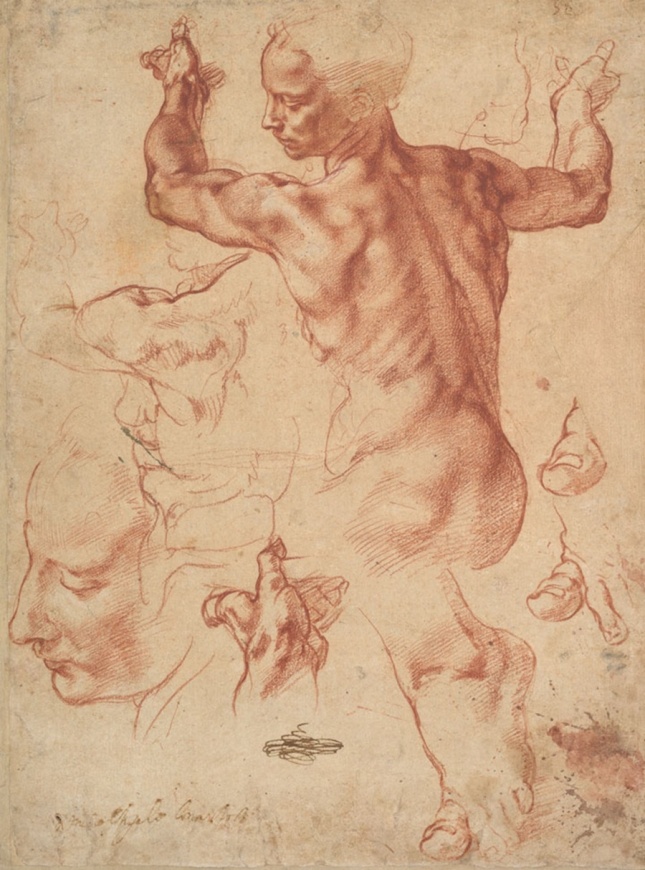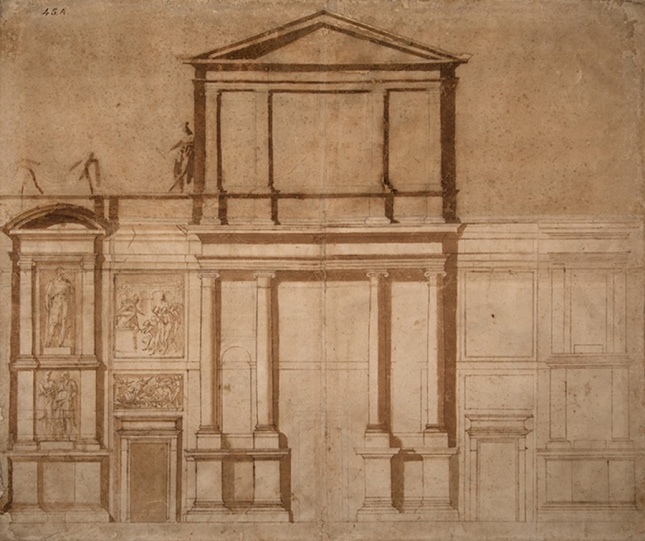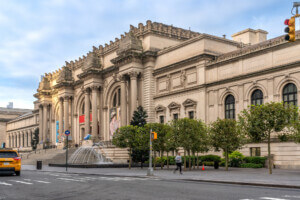This has been an exhilarating year for those who cherish drawings. Following on the heels of the marvelous Thaw collection last fall at the Morgan, the Metropolitan Museum of Art’s winter season opened with an extravagantly wonderful exhibition of Michelangelo drawings and designs, Michelangelo: Divine Draftsman and Designer. The show, which was sponsored by Morgan Stanley and was open from November 13, 2017 to February 12, 2018, consists of 133 drawings, sculpture, and a replica of the Sistine Chapel, each requiring scrutiny and contemplation, which isn’t easy given the crowds. Many years of intense scholarly study by Carmen C. Bambach, curator in the Department of Drawings and Prints at the Met, has culminated in a wide-ranging survey of the artist’s work, his mentors, and students.
Besides offering what seems like an endless sequence of exciting images, the show highlights some important issues, not the least of which is the current devaluation of the medium as a means of visualizing and understanding the world we inhabit. While it disappears from our academies today, during Michelangelo’s day, drawing was just becoming a significant component in art and culture in the mid-15th century. The Accademia delle Arti del Disegno in Florence had just opened, and within its program, drawing assumed an important position alongside architecture, sculpture and painting. Also, the “finished drawing’ was highly prized and its worth accrued if given the designation, “dalla sua mano” (by his very hand).

Alexander Perrig, in his book on Michelangelo’s drawings, Michelangelo’s Drawings: The Science of Attribution, eloquently describes the emergent tendency to value the evidence of a personal language and unique vision: He writes: “But drawing is not a bone displayed for veneration. It embodies a piece of the imaginative world of its creator.” This show charts the development and range of Michelangelo’s vision. We enter his tortured, anxiety-ridden world and find that the work seems to speak to our historical moment despite the centuries that separate us, for they offer powerful insights into the human condition. And it is through the intimate touch–hand to paper–that these sights and insights are given form. Exhibitions focusing on drawings help keep the idea alive that drawing cannot be supplanted by the digital rendering. While there might be some overlap, each is capable of accomplishing different tasks in different ways. Personal finished drawings were precious then. Michelangelo gave them as heart-felt gifts to dearest friends–a gesture that wasn’t valued in monetary terms, but rather appreciated as a sign of intimacy and friendship.
As Bambach discusses each of the works in the show, she addresses the contested drawings and throws her hat into the ring siding with one or the other Michelangelo scholars and connoisseurs based on her system of observation and physical evidence. The contention over the attributions of drawings by Michelangelo has a long history of scholarly literature and many unsolved problems remain. The enormous weight given to this discussion provokes a question: Why is attribution so important? Too often authentication serves to enhance value. But it is of great significance according to Perrig, who has disattributed a great number of generally accepted works. “Every misattribution tends to distort historical reality as a whole by imputing to an artist someone else’s thoughts…it saddles the creativity of the assumed creator with contradictions that did not exist, and at the same time makes the art of the actual creator appear more one-sided and insignificant than it actually was.”
The exhibition proposes a broad definition of drawing as a medium but also as a means for thought. The wonderful book produced for the exhibition, written by Bambach with essays by Claire Barry, Francesco Caglioti, Caroline Elam, Marcella Marongiu, and Mauro Mussolin, does much to extend our notion of what constitutes drawing. It categorizes the many applications: sketches, finished and unfinished drawings (a theme explored somewhat murkily in the recent exhibition Unfinished: Thoughts Left Visible at the Met Breuer, drawings from wax models, presentation drawings, “modani” or full-scale templates, drawings for painters such as Pontormo, to execute and the architectural plans–each distinct in its application while sharing a common hand and concept-driven project.

The exhibition also provides insight into the artist as a teacher. In the hand-written notes that appear on the drawings, we see Michelangelo prodding and encouraging his students. Their studies are punctuated by his urgings to “draw!” and to “be patient.” The attribution dilemma is complicated by these student drawings, some of which attained a level sufficiently sophisticated enough to confuse many scholars.
The illusionistic architectural elements, such as the structure of the Sistine Chapel, offer insight into Michelangelo’s emplacement of figures. The “quadro” or designated setting was a means for both isolating and connecting the narrative. It deployed a system entirely different from the pre-Renaissance predellas which consisted of a large iconic image resting on a series of small, distinct panels that carried a thematic narrative. These isolated, elaborated altar-like structures appeared like out-scale objects to heighten faith. Instead, Michelangelo contrived an entirely novel system by melding an illusionistic architecture based on while deviating from the actual one. This structure or invented “architecture” established a realm for the figures to inhabit and in many cases against which they appeared to struggle. The result was a kind of total design, revolutionary in its time. Mauro Mussolin’s useful essay finds a evidence of this approach even in such details such as the corner volutes in the Laurentian library, that he finds key to understanding Michelangelo’s ability to contrive an organic unity. These details attest to his ability to visualize the projection of space and his stunning visual memory. Adding to this notion, the late Leo Steinberg includes a temporal element in his design process, in his discussion of Michelangelo’s last painting, “On the deepest level of Michelangelo’s visual thinking, the meaning of the historical occasions as a rite of foundation and an affirmation of faith is expressed in the tectonic character of the design.”
It is an arduous task to sum up grand exhibitions of this sort–a delight to the eyes and to the spirit. It is a profound reckoning not to be missed.











